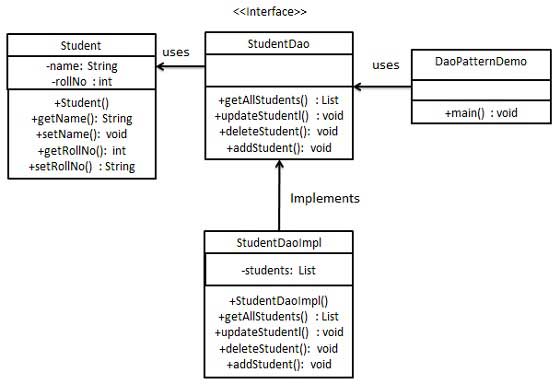- 数据访问对象模式
- 设计模式-主页
- 设计模式-概述
- 设计模式-工厂模式
- 抽象工厂模式
- 设计模式-Singleton模式
- 设计模式-生成器模式
- 设计模式-原型模式
- 设计模式-适配器模式
- 设计模式-桥梁模式
- 设计模式-过滤器模式
- 设计图案-复合图案
- 设计图案-装饰图案
- 设计图案-立面图案
- 设计图案-飞线图案
- 设计模式-代理模式
- 责任链模式
- 设计模式-命令模式
- 设计模式-解释器模式
- 设计模式-迭代器模式
- 设计模式-中介模式
- 设计模式-Memento模式
- 设计模式-观察者模式
- 设计模式-状态模式
- 设计模式-空对象模式
- 设计模式-战略模式
- 设计模式-模板模式
- 设计模式-访客模式
- 设计模式-MVC模式
- 业务代表模式
- 复合实体模式
- 数据访问对象模式
- 前控制器模式
- 拦截过滤器模式
- 服务定位器模式
- Java传输对象模式
数据访问对象模式
Data Access Object Pattern or DAO pattern is used to separate low level data accessing API or operations from high level business services. Following are the participants in Data Access Object Pattern.
Data Access Object Interface - This interface defines the standard operations to be performed on a model object(s).
Data Access Object concrete class - This class implements above interface. This class is responsible to get data from a data source which can be database / xml or any other storage mechanism.
Model Object or Value Object - This object is simple POJO containing get/set methods to store data retrieved using DAO class.
Implementation
We are going to create a Student object acting as a Model or Value Object.StudentDao is Data Access Object Interface.StudentDaoImpl is concrete class implementing Data Access Object Interface. DaoPatternDemo, our demo class, will use StudentDao to demonstrate the use of Data Access Object pattern.

Step 1
Create Value Object.
Student.java
public class Student {
private String name;
private int rollNo;
Student(String name, int rollNo){
this.name = name;
this.rollNo = rollNo;
}
public String getName() {
return name;
}
public void setName(String name) {
this.name = name;
}
public int getRollNo() {
return rollNo;
}
public void setRollNo(int rollNo) {
this.rollNo = rollNo;
}
}
Step 2
Create Data Access Object Interface.
StudentDao.java
import java.util.List;
public interface StudentDao {
public List getAllStudents();
public Student getStudent(int rollNo);
public void updateStudent(Student student);
public void deleteStudent(Student student);
}
Step 3
Create concrete class implementing above interface.
StudentDaoImpl.java
import java.util.ArrayList;
import java.util.List;
public class StudentDaoImpl implements StudentDao {
//list is working as a database
List students;
public StudentDaoImpl(){
students = new ArrayList();
Student student1 = new Student("Robert",0);
Student student2 = new Student("John",1);
students.add(student1);
students.add(student2);
}
@Override
public void deleteStudent(Student student) {
students.remove(student.getRollNo());
System.out.println("Student: Roll No " + student.getRollNo() + ", deleted from database");
}
//retrive list of students from the database
@Override
public List getAllStudents() {
return students;
}
@Override
public Student getStudent(int rollNo) {
return students.get(rollNo);
}
@Override
public void updateStudent(Student student) {
students.get(student.getRollNo()).setName(student.getName());
System.out.println("Student: Roll No " + student.getRollNo() + ", updated in the database");
}
}
Step 4
Use the StudentDao to demonstrate Data Access Object pattern usage.
DaoPatternDemo.java
public class DaoPatternDemo {
public static void main(String[] args) {
StudentDao studentDao = new StudentDaoImpl();
//print all students
for (Student student : studentDao.getAllStudents()) {
System.out.println("Student: [RollNo : " + student.getRollNo() + ", Name : " + student.getName() + " ]");
}
//update student
Student student =studentDao.getAllStudents().get(0);
student.setName("Michael");
studentDao.updateStudent(student);
//get the student
studentDao.getStudent(0);
System.out.println("Student: [RollNo : " + student.getRollNo() + ", Name : " + student.getName() + " ]");
}
}
Step 5
Verify the output.
Student: [RollNo : 0, Name : Robert ] Student: [RollNo : 1, Name : John ] Student: Roll No 0, updated in the database Student: [RollNo : 0, Name : Michael ]